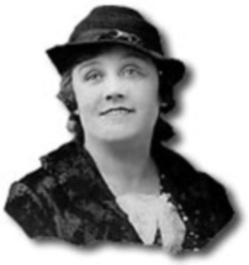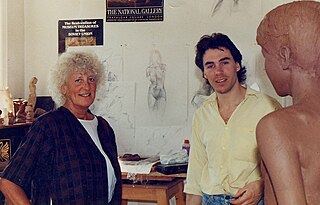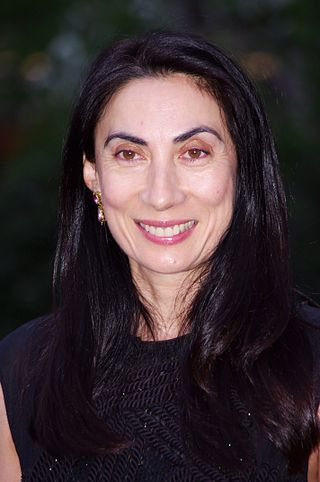
Glenys Barton (born 1944) is a sculptor working mainly in ceramic and bronze.

Glenys Barton (born 1944) is a sculptor working mainly in ceramic and bronze.
Barton was born in Stoke-on-Trent in 1944 and now lives in and works in Essex, UK. [1] She studied at the Royal College of Art from 1968-1971, where Eduardo Paolozzi was her tutor.
Barton's ceramic work of the 1970s focused on precise geometrical forms. [2] She was the British prize winner at the International Ceramics Exhibition in 1972 and was invited to serve on the newly formed Crafts Advisory Committee, as its youngest member from 1974-76.
Angela Flowers offered Barton her first solo exhibition in London and Barton has presented regular solo exhibitions with them since 1974.
Two early works are included in the Ceramics Galleries at the Victoria and Albert Museum. These works illustrate her early concern for precision and interest in the use of industrial processes of ceramic production. She has collaborated with Wedgwood. [3] As artist-in-residence from 1976 to 1978 she worked with the Wedgwood Factory, Barlaston, Stoke-on-Trent to produce 26 sculptures.
Since the 1980s her work has centred on the human form, the head in particular. In 1993 her work of Jean Muir was shown in the 'Portrait Now' exhibition at the National Portrait Gallery London and was used as the lead publicity image for the exhibition. The NPG subsequently added a Jean Muir figure to their collection and commissioned a sculpture of Glenda Jackson. Barton's Helena Kennedy and a head of Jean Muir are in the collection of the Scottish National Portrait Gallery.
A monograph on her work, 'Glenys Barton', was published by Momentum in 1997. [1]
She has many sculptures in collections internationally and her work has been exhibited widely in Britain and abroad. [4] Two simultaneous retrospective exhibitions in 1997 examined separate aspects of her work - portraiture at the National Portrait Gallery and her generic figurative work at Manchester Art Gallery. These two shows came together the following year, 1998, at the Potteries Museum & Art Gallery in Stoke-on-Trent, her home town. [5]
In 2004 she worked with Roger Michell and Kevin Loader on the making of the film Enduring Love and became the inspiration for the sculptor played by Samantha Morton. All the sculpture in the film is by Barton including specially commissioned portraits of Daniel Craig and Bill Nighy. [6]
An early Laban dance training and an interest in modern dance continues to inform her most recent work. In 2005 she received a public art commission for Hextable Dance. [7] The work was inspired by the forms and movement of dancers Antonia Grove and Theo Clinkard (Hextable Dance's first resident artists) as they worked with choreographer Rafael Bonachela.
Barton describes her work:
My subject is always humanity: sometimes a specific human, sometimes human relationships, sometimes human society. The forms may be heads, parts of figures, whole figures or figures within figures. Heads and hands particularly fascinate me. As I work I feel that I am directly linked with those who have tried to fashion the human form from the earliest times. My greatest achievement would be to create a timeless image.� Glenys Barton 2011 [8]
Exhibition Catalogues
Monographs
Francis Upritchard is a New Zealand contemporary artist based in London. In 2009, she represented New Zealand at the Venice Biennale.

Clarice Cliff was an English ceramic artist and designer. Active from 1922 to 1963, Cliff became the head of the Newport Pottery factory creative department.

Susan Vera Cooper OBE was a prolific English ceramic designer working in the Stoke-on-Trent pottery industries from the 1920s to the 1980s.

Dame Elisabeth Jean Frink was an English sculptor and printmaker. Her Times obituary noted the three essential themes in her work as "the nature of Man; the 'horseness' of horses; and the divine in human form".

Creamware is a cream-coloured refined earthenware with a lead glaze over a pale body, known in France as faïence fine, in the Netherlands as Engels porselein, and in Italy as terraglia inglese. It was created about 1750 by the potters of Staffordshire, England, who refined the materials and techniques of salt-glazed earthenware towards a finer, thinner, whiter body with a brilliant glassy lead glaze, which proved so ideal for domestic ware that it supplanted white salt-glaze wares by about 1780. It was popular until the 1840s.

John Edward McKenzie Lucie-Smith, known as Edward Lucie-Smith, is a Jamaican-born English writer, poet, art critic, curator and broadcaster. He has been highly prolific in these fields, writing or editing over a hundred books, his subjects gradually shifting around the late 1960s from mostly literature to mostly art.

Dame Lucie Rie, was an Austrian-born, independent, British studio potter working in a time when most ceramicists were male. She is known for her extensive technical knowledge, her meticulously detailed experimentation with glazes and with firing and her unusual decorative techniques.

Wedgwood is an English fine china, porcelain and luxury accessories manufacturer that was founded on 1 May 1759 by the potter and entrepreneur Josiah Wedgwood and was first incorporated in 1895 as Josiah Wedgwood and Sons Ltd. It was rapidly successful and was soon one of the largest manufacturers of Staffordshire pottery, "a firm that has done more to spread the knowledge and enhance the reputation of British ceramic art than any other manufacturer", exporting across Europe as far as Russia, and to the Americas. It was especially successful at producing fine earthenware and stoneware that were accepted as equivalent in quality to porcelain but were considerably cheaper.

Mintons was a major company in Staffordshire pottery, "Europe's leading ceramic factory during the Victorian era", an independent business from 1793 to 1968. It was a leader in ceramic design, working in a number of different ceramic bodies, decorative techniques, and "a glorious pot-pourri of styles - Rococo shapes with Oriental motifs, Classical shapes with Medieval designs and Art Nouveau borders were among the many wonderful concoctions". As well as pottery vessels and sculptures, the firm was a leading manufacturer of tiles and other architectural ceramics, producing work for both the Houses of Parliament and United States Capitol.

Anh Duong is a French-American artist, actress, and model. She is known for her self-portraits, which she has compared to a visual diary, as well as portraits of significant art collectors and influencers.

Ng Eng Teng, The Grandfather of Singapore Sculpture was a sculptor in Singapore known for his figurative sculptures, many of which are found in public locations around Singapore. His legacy include the Mother And Child bronze sculpture outside Far East Shopping Centre along Orchard Road, and The Explorer located at the entrance of the Singapore Art Museum.

Charles Vyse, was an English studio potter, noted for producing colourful figurines of characters seen on London streets.
Robin Warwick Gibson was a British gallery curator and art historian best known for his work at the National Portrait Gallery in London between 1968 and 2001, including eight years as Chief Curator. He was responsible for many innovations in the management of the gallery and published a number of significant academic works on the gallery's collections during his career.
Nicola Hicks is an English sculptor, known for her works made using straw and plaster.
Veronica Maudlyn Ryan is a Montserrat-born British sculptor. She moved to London with her parents when she was an infant and now lives between New York and Bristol. In December 2022, Ryan won the Turner Prize for her 'really poetic' work.
Beth Cullen-Kerridge is an English sculptor.

Katherine Gili is a British sculptor. Born in Oxford in 1948, is the daughter of Catalan publisher and translator Joan Gili and sister of the film-maker Jonathan Gili. She graduated from Bath Academy of Art in 1970 and then studied for two years at St Martin's School of Art. Gili subsequently taught at a number of art schools; most notably St Martin's and Norwich between 1972 and 1985.
Karin Margareta Jonzen, née Löwenadler, was a British figure sculptor whose works, in bronze, terracotta and stone, were commissioned by a number of public bodies in Britain and abroad.

Millicent (Millie) Jane Taplin (1902–1980) was a British designer and painter of ceramics who spent most of her career at Josiah Wedgwood and Sons (1917–1962). She was trained in painting by Alfred and Louise Powell, and supervised Wedgwood's ceramics painters. She became a designer of decorative patterns in 1929 and by the mid-to-late 1930s was one of the company's main designers, although she did not design pottery shapes. She was one of only two working-class women to become a successful ceramics designer before the Second World War. Her tableware designs were exhibited by Wedgwood at Grafton Galleries in London in 1936, and several of her designs are now on display at the V&A Museum. Her design "Strawberry Hill", with Victor Skellern, was awarded the Council of Industrial Design's Design of the Year Award in 1957.
Victor G. Skellern (1909–1966) was a British ceramics designer and stained glass producer who was the art director at Wedgwood from 1934 to 1965. He helped to modernise Wedgwood, and his design work was a factor in the company's resurgence after 1935. He was also known for employing well-known designers from outside the company. Skellern's ceramics designs were exhibited at Grafton Galleries (1936) and the Britain Can Make It exhibition (1946) in London. Some of his designs are now on display at the V&A Museum, Yale Center for British Art, Museum of Applied Arts & Sciences and the Wedgwood Museum. His design "Strawberry Hill", with Millicent Taplin, was awarded the Council of Industrial Design's Design of the Year Award in 1957.